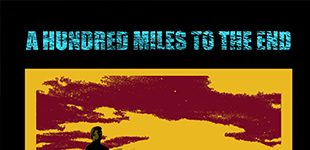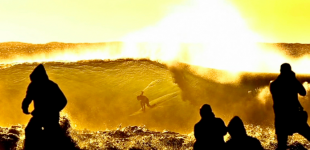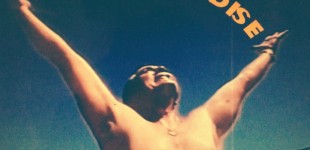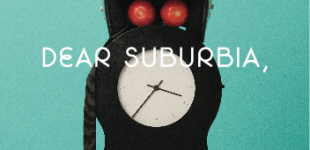
the nine lives of timmy turner.
“What you see here represents all that remains of Turner’s skull. An infection took the rest of it — and nearly his life. That didn’t stop him from making his pioneering surf films. But it did force him to radically alter his approach.”
Article by Thayer Walker

Scars cover so much of Timmy Turner’s body that they look like a genetic trait. They start on his feet, where small pale marks testify to years of tap-dancing over sharp coral reefs. The serious business, however, begins with the two four-inch gashes etched into his right ankle, souvenirs from shattering the bone in a San Diego wave pool. The small discolored slash on his right pinkie? Hardly worth mentioning on a body so tattooed by carnage, except that Turner got this one in Indonesia and had to finish the three stitches when his friend couldn’t stomach it anymore. His back, chest, and arms are painted with scars of various sizes and severities, many of them parting gifts from the shallow, dangerous reef breaks he loves to surf.
But here in the Icelandic village of Kópasker, 18 miles below the Arctic Circle, these wounds are buried under layers of fleece, and all attention is on the sea. When Turner’s caravan arrived a half-hour earlier the streets were empty. Now, as the three pro surfers he brought with him paddle into the bay, some of the 100-odd locals emerge to watch the spectacle. “No one has ever surfed here before,” a rosy-cheeked Viking named Arnbjorn tells us. “We do some crazy things” — among them cliff skiing and rappelling hundreds of feet to collect seabird eggs — “but nothing like this.” Then it starts to snow.
Turner, a 27-year-old surf-film director whose pioneering movies have developed a cult following, shoots the action from the rocks, his mood improving as the weather worsens. He’s been in Iceland for seven days now, but the film is two years in the making, and this is the closest he has come to capturing the shot he’s been searching for: an inside-a-barrel view of a blizzard.
A plastic jacket protects his camera, and Turner is bundled in a parka. Every so often he slides off his hood, exposing his shaved head. In so doing he reveals another scar, one that makes all the others look insignificant: a deep-pink zipper snaking from ear to ear like a grisly yin-yang, crossed by a railroad track of staple marks. It’s the kind of scar that scares kids and intrigues adults, and it’s the reason Turner is chasing waves along a stretch of coast close enough to the Arctic that polar bears have been known to sail over on icebergs.
Kópasker may be one of the more improbable surf spots you’ll ever find, but this is one of the more improbable survival stories you’ll ever hear, and it all begins in the deep, resilient channels of Timmy Turner’s brain.
After more than a decade working over operating tables, few cases surprise Dr. Richard Kim. The California neurosurgeon has removed brain tumors the size of softballs and once had to bury his knee into a patient’s forehead to leverage a six-inch knife out of his skull. He has operated on infants with cranial fractures (“The skull looked like a cracked ping-pong ball,” he says) and a multiplatinum rapper with gunshot wounds (“He was very angry”). Kim has cut into so many skulls that the familiar process offers all the novelty of opening a can of tomatoes. So on December 17, 2005, when Timmy Turner was wheeled into the operating room of Newport Beach’s Hoag Memorial Hospital Presbyterian, Kim wasn’t anticipating anything he hadn’t seen before. Then he opened Turner’s head.
“Normally you see the brain,” says the 45-year-old surgeon, “but all I saw was white pus. It was the most serious infection of the brain I have ever seen.”
At best, Kim explained to the Turner family, they might expect Timmy to survive in a vegetative state, but most likely the father of two was going to die. Bacteria called methicillin-resistant staphylococcus aureus (better known as the worst type of staph infection on the planet) had eaten through Turner’s skull like acid and turned his head into a pressure cooker. Doctors suspected he picked it up surfing near his home in Huntington Beach after heavy rains had swept a stew of human and industrial waste into the ocean. His temperature hit 106.7, and his left eyeball bulged from its socket. “Another centimeter,” says his father Tim, “and his eye would have been on the pillow.”
The damage was so extensive that Kim had to perform a hemicraniectomy, the Hail Mary of brain surgeries that had fallen out of favor decades ago. To relieve the stress caused by Turner’s swollen brain and to clean the infection, Kim would remove half of the skull.
During the two-hour surgery, hundreds of people turned the hospital lobby into a standing-room-only affair in support of the “First Family of Huntington Beach,” as Timmy’s high school surf coach Andy Verdone calls the Turners. The clan has run the Sugar Shack Cafe, a greasy spoon and unofficial town hall a block and a half from the beach, since 1967. Timmy started working there before he was tall enough to reach the register. He joked with the regulars, cleaned the toilet without being asked, and eventually used his tip money to fund his films.
At the hospital friends and family consoled one another by swapping stories about Turner. Like the time in the eighth grade when he got so sick of wearing braces that he pulled them off with pliers. Or when he was in Indonesia surfing and had to stitch up a stranger’s back, a cut so deep you could stick your finger in to the first knuckle. Remember hitting the water with him before his LASIK surgery? His friends called it Braille surfing, but even without his glasses Turner would drop into 20-footers. And how about the time his mom had to fly his older brother Ryan to Indonesia to drag Timmy home to college after four months away. He still didn’t come back.
Surfing came naturally to Turner. He first picked up a board at age five and in high school was captain of the surf team. He took pride in his talent because as a kid he had struggled with the one thing that came naturally to others. Growing up, he suffered from a severe speech impediment that kept him in special education classes until the seventh grade. Kids teased him ruthlessly. The experience fostered a humility that stayed with him even after he became one of the hottest surfers in a town that proudly dubs itself “Surf City, USA.” As an adult he progressed to the point where he could speak comfortably to large audiences, whether theaters full of moviegoers or auditoriums of schoolchildren, and a demure charm emerged.
“Timmy is the kind of person people fall in love with immediately,” says his wife Jessica, who ought to know. She met Turner as a teenager at the Sugar Shack in 1999 when he mumbled something about taking her order. “He was really shy,” Jessica recalls, “and had the biggest blue eyes.” She had the $6 teriyaki bowl. “It was the best meal of my life.” They married three years later, when he was 21 and she was 22.
By that point, Turner had developed a passion for making surf films. His freshman year in high school, he had begun borrowing his dad’s camcorder to record his and his friends’ exploits, and at 17 he made his first movie, shooting in Indonesia. He returned there often and spent months on an uninhabited, malaria-ridden island filming and surfing waves so big and perfect and hollow and dangerous that they bordered on theoretical. He turned the adventure into Second Thoughts, the movie that launched his cult stardom and won Surfer Magazine’s 2004 Video of the Year award.
Later that year, after the devastating Asian tsunami, he went back to Indonesia to make another movie. The Tsunami Diaries, however, was not about waves; Turner and a crew of friends chartered a sailboat and delivered 75 tons of food and supplies to remote islands neglected by relief efforts. Ten months later Turner’s own life hung in jeopardy.
It started with the headaches. Severe headaches. Headaches that felt like a power drill spinning through his skull: a harbinger of events to come. The pain only intensified, but after a couple days of this Turner still refused to see a doctor. “I’ll get better,” he snarled to Jessica. He didn’t. And the man known for his soft smile and easygoing nature began to slam doors and scream irrationally.
By the third day, Jessica grew scared enough to leave the house, taking her daughters with her to her mother’s in San Diego. What she didn’t know — what no one knew — was that staph was burning through Turner’s sinuses and infecting his frontal lobe, swelling the area responsible for emotional control and judgment.
The next day Turner’s behavior worsened, and his uncle Joe called the paramedics. Turner greeted them in raging delirium, throwing the gurney at them. They figured Turner was whacked out on PCP and refused to take him. Later that night Turner collapsed in his bedroom. When his father Tim checked on him in the morning, Turner’s face was swollen like a balloon. It was “as if his brain was popping through his face,” his dad recalls.
His dad and uncle Joe and brother Ryan wrestled Turner into the car and drove him to the Huntington Hospital. By the time they arrived Timmy’s body hung limp. The staff told them to take a number. “You don’t understand,” Ryan pleaded, but they soon did once they read Turner’s temperature. “All of a sudden everyone was putting on masks and gloves, and doctors were coming in from everywhere,” Ryan says. “All hell broke loose.” The doctors quarantined the area, fearing a possible case of meningitis had turned Turner into a human biohazard. He began to spasm violently, and the hospital transferred him to Hoag, which was better equipped to handle such a severe case.
Turner’s mother, Michele, remembers the last moment she saw her son conscious. “He let out this pathetic cry,” she says, “and fell into a coma.”
Turner survived the first surgery but remained coma tose and on life support. Dr. Kim described the results to the family as a mixed blessing.
“He’s alive,” he told them, “but in all likelihood he’s going to have a lot of deficits and need a lot of care.”
Over the course of that first week an avalanche of potentially fatal maladies pounded Turner: meningitis, acute respiratory distress syndrome, pneumonia. Jessica split her time between her husband at the hospital and her kids at home. On Christmas she curled up on the couch and cried. “I looked at a picture of our family, and I thought, Is this my life now? My husband is a complete vegetable?” Two days into the new year, and two weeks after the first surgery, Kim removed more of Turner’s forehead — a palm-size chunk of infected bone — leaving him with just one quarter of his skull.
For the rest of the article visit http://www.mensjournal.com/timmy-turner














